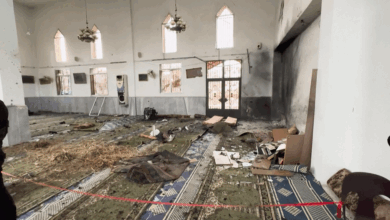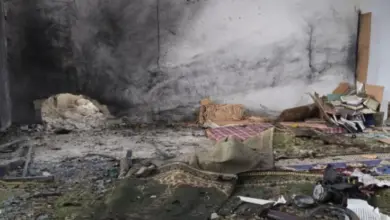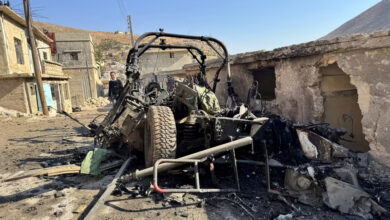
IDLIB — “Leave Homs alone and shell us instead,” read the banner hoisted by the people of the Syrian city of Idlib in support of their comrades in Homs, a city in shambles after continuous bombardment by President Bashar al-Assad’s forces.
The banner was the idea of a young man who urged his peers to distribute similar banners among protesters planning to take part in a demonstration on Friday, 2 March, which was to call for arming dissident soldiers of the Free Syrian Army.
The move flagrantly defied pro-regime snipers stationed on the roofs of houses at the so-called “security square,” an area that hosts facilities belonging to countless state security apparatuses.
The Friday protest ended with no deaths reported. Revolutionaries celebrated with dances and songs, unaware that Assad’s forces would respond to their call, not by leaving Homs and bombing Idlib, but by targeting both.
Early on Saturday, 10 March, Idlib was meeting its fate. Regime forces started by bombing an inhabited building in the city’s northern region of Jaamea. Some citizens scurried to take women and children to shelters to escape the shelling — basements previously prepared at the bottom of buildings whose walls, nevertheless, were not strong enough to resist missiles. Others assisted dissident troops in planting landmines at the city’s entrances that would be detonated as soon as attacking tanks tried to get in.
“I took my family down to the shelter. … I am still ignorant of what Assad’s gangs intend to do with us,” Abu Mohamed told Al-Masry Al-Youm. One activist interrupted him and advised him to leave as soon as possible, to which Abu Mohamed replied that he does not have a car. He eventually ran under snipers’ shots and made it to a group of dissident soldiers that had prepared vehicles to evacuate the residents.
We too were advised by activists to leave as the regime tanks approached. They drove us away by motorbikes, and, on the way, they told us that three army tanks had been hit at Thalathini Street.
We decided to head to Thalathini to take photos but found that it was being showered with fire shots and missiles from every direction, and snipers were standing at the top of nearby buildings.
The mounting bombardment increased the numbers of casualties, who had been transported to the makeshift hospital erected inside Saad ibn Abi Waqas Mosque near Thalathini. Some missiles missed the mosque and instead hit the opposite building.
Regime forces started to storm the nearby houses and detained many inhabitants. Revolutionary activists stopped a large truck to evacuate reporters, and told us to crouch so as not to be an easy target for snipers.
It would have been insane to remain out in the streets, not only due to the bombing, but also given the falling buildings and the omnipresence of Assad’s informants, who drove their captives to a school in northern Idlib that they had turned into a major detention camp. Therefore, we attempted to make it to the activist-run media center.
That was not an easy task because the streets were too narrow to admit passing cars. So we proceeded on foot, making sure to keep our heads down as bullets passed over as fast as thunder.
Arriving there, we overheard mortar missiles gradually approaching, and reconnaissance aircrafts appeared in the sky. We received reports that Assad’s forces had taken over Idlib’s main streets and were informed that the weapons used by the dissident troops were mostly defective.
Tensions were partially mitigated with the news that three tanks defected from Assad’s forces, to which activists cheered. But the jubilation went out on learning that regime forces targeted the three tanks and killed their crews.
As the firing sounds approached, reporters were told to move to an underground chamber. We stayed there for 15 minutes before hearing shots of gunfire right above the media center from an unknown source, to which Assad’s forces replied with a missile that landed next to the center.
Luckily, under the media center there was a cellar leading to another alley that was far enough from the bombardment. We were told to go through it. At its end, we reached a house that had been turned into a command unit for the Free Syrian Army. There one trooper told us that Assad’s forces had attacked the Red Crescent Hospital and arrested a number of wounded people.
Another activist from northern Idlib told us that a pro-Assad infantry division executed 20 activists simultaneously outside a primary school.
Activists kept flowing into the media center and asked its members to hasten the evacuation as Assad’s forces were on their way to the area, the name of which we forgot to ask given the tense atmosphere.
We went out protected by dissident soldiers while bullets were flying over. We were the only people on the streets. The activists asked us to shut off our cameras and any other source of light, and to remain close to the buildings’ walls while walking.
We took shelter at an old woman’s house to wait before leaving Idlib. Our host told us that she did not intend to leave home and prefers to die along with her sons and grandsons.
At 7 pm, there was a knock at the door. It was two activists telling us they had secured a way out despite the unstable situation. They said 15 people had been killed that day and that snipers had been foiling attempts to rescue those trapped under their demolished homes.
Learning that we would make our journey on foot, we decided to leave some of our luggage. We followed the safety instructions given by the activists until we reached some farmland, the name of which was kept secret, which was part of an evacuation route for Idlib citizens. Crouching, we hurried through olive trees for nearly 25 km and arrived to Maarat Misrin, a village in Idlib’s northern rural region.
At dawn, we were surprised to discover that we had been sneaking over the night within the reach of Syrian regime tanks. On the next day, we arrived at the last village near the borders with Turkey. We walked for 10 km to cross the border, where Abu Hassan, a volunteer who had been working for three months to help shepherd migrant citizens and reporters out of Syria, pleaded for help for his country.
“Bashar had succeeded in giving the revolution a sectarian dimension. He targets Sunnis alone … Most of the thugs spread around the streets to massacre unarmed people are from his Alawite sect,” Hassan claimed.
“Meanwhile, Arabs stand idly watching the bloodshed… We are not asking for food or medicine, we want arms to defend ourselves.”




